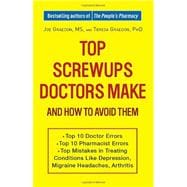
What is included with this book?
| Acknowledgments | p. xi |
| Preface | p. 1 |
| Safe Patient Checklist | p. 5 |
| Introduction | p. 7 |
| Top 10 Screwups Doctors Make | p. 27 |
| Diagnostic Disasters | p. 38 |
| Top 10 Reasons Why Doctors Screw Up Diagnoses | p. 46 |
| Preventing Diagnostic Problems | p. 66 |
| Top 10 Screwups Doctors Make When Prescribing | p. 78 |
| Drug Interactions Can Be Deadly | p. 96 |
| Top 10 Screwups Pharmacists Make | p. 111 |
| Generic Drug Screwups | p. 122 |
| The Screwing of Senior Citizens | p. 143 |
| Top 10 Screwups Patients Make | p. 168 |
| Closing the Communication Chasm | p. 179 |
| Top Screwups in Common Conditions | p. 189 |
| Acne | p. 193 |
| Alzheimer's Disease | p. 195 |
| Arthritis | p. 199 |
| Asthma | p. 203 |
| Attention Deficit Disorder (ADD) | p. 205 |
| Back Pain | p. 208 |
| Breast Cancer | p. 209 |
| Celiac Disease | p. 211 |
| Deep Vein Thrombosis (DVT) | p. 213 |
| Depression | p. 215 |
| Diabetes | p. 218 |
| Fibromyalgia | p. 223 |
| Heartburn | p. 225 |
| Hypothyroidism | p. 228 |
| Migraine Headache | p. 233 |
| Osteoporosis | p. 235 |
| Prostate Problems | p. 238 |
| Tick-borne Diseases | p. 242 |
| Top 10 List of Potentially Problematic Pills | p. 245 |
| Top 10 Tips and Questions Lists | p. 255 |
| Tips to Stopping Screwups in Hospitals | p. 255 |
| Screwups Doctors Make | p. 256 |
| Diagnostic Screwups | p. 256 |
| Reasons Why Doctors Screw Up Diagnoses | p. 257 |
| Questions to Ask to Reduce Diagnostic Disasters | p. 257 |
| Screwups Doctors Make When Prescribing | p. 258 |
| Questions to Ask Your Doctor When You Get a Prescription | p. 258 |
| Tips for Preventing Dangerous Drug Interactions | p. 259 |
| Screwups Pharmacists Make | p. 259 |
| Tips for Taking Generic Drugs | p. 260 |
| Tips to Surviving Old Age | p. 260 |
| Screwups Patients Make | p. 260 |
| Questions to Ask Your Doctor Before Agreeing to Surgery | p. 261 |
| Tips to Promote Good Communication | p. 261 |
| Notes | p. 265 |
| Index | p. 303 |
| Table of Contents provided by Ingram. All Rights Reserved. |
The New copy of this book will include any supplemental materials advertised. Please check the title of the book to determine if it should include any access cards, study guides, lab manuals, CDs, etc.
The Used, Rental and eBook copies of this book are not guaranteed to include any supplemental materials. Typically, only the book itself is included. This is true even if the title states it includes any access cards, study guides, lab manuals, CDs, etc.